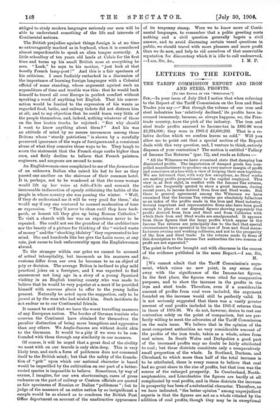THE TARIFF COMMISSION REPORT AND IRON AND STEEL PROFITS. 15o
via EDITOR OF TIIR "SPECTATOR."] SIR,—In your issue of July 23rd I notice that when referring to the Report of the Tariff Commission on the Iron and Steel
Trades you say :—" But though the volume of our iron and
steel industries has ' relatively declined,' its profits have in-, creased immensely, because, as always happens, we, the Free-
trade country, have the pick of the industry. The iron and steel trade profits assessed to Income-tax in 1895-96 were £1,934,000; they were in 1901-2 26,600,203. That is a re- lative decline which we confess leaves us cold." Will you allow me to point out that a special section of the Report deals with this very question, and, I venture to think, entirely disposes of your contention ? The section is entitled " Fallacy of Income Tax Returns" (par. 72), and reads as follows :—
"All the Witnesses we have examined state that dumping has diminished profits. The importation of dumped goods has com- pelled manufacturers to produce on a very narrow margin of profit and sometimes at a loss with a view of keeping their men together. We are informed that, with very few exceptions, no Steel works are making profits proportionate to the capital employed. This view is, at first sight, in conflict with the Income Tax returns, which are frequently quoted to show a great increase, during recent years, in income derived from Iron and Steel works. But there is general agreement among the Witnesses we have examined that the Income Tax returns are absolutely fallacious as an index of the profits made in the Iron and Steel industry. Several important and representative firms also have been good enough to place at our disposal figures showing separately the profits derived from Iron and Steel and from Collieries with which their Iron and Steel works are amalgamated. It appears from these figures that the large profits which appear in the Income Tax returns are principally due to the fact that special circumstances have operated in the case of Iron and Steel manu- facturers owning and working collieries, and not to the prosperity of the Iron and Steel 'trade. In the returns made by firms of this description to the Income Tax authorities the two sources of profit are not separated."
The point is further brought out with clearness in the course of the evidence published in the same Report.—I am, Sir, &c., H. [We cannot admit that the Tariff Commission's argu- ment, which raises no new point, in any sense does away with the significance of the Income-tax figures, In the first place, the figures were cited for comparative purposes, and to show the increase in the profits in the irgn and steel trade. Therefore, even if a considerable amount of profits from coal were included, the argument founded on the increase would still be perfectly valid. It is not seriously suggested that there was a vastly greater amount of coal profits included in the 1901-2 returns than in those of 1895-96. We do not, however, desire to rest our contention solely on the point of comparison, but are per- fectly willing to meet the advocates of the Tariff Commission on the main issue. We believe that in the opinion of the most competent authorities no very considerable amount of the profits of the iron trade, taken as a whole, arises from coal mines. In South Wales and Derbyshire a good part of the increased profits may no doubt be fairly attributed to coal ; but these districts constitute only a comparatively small proportion of the whole. In Scotland, Durham,. and Cleveland, to which more than half of the total increase is to be attributed, there is every reason to believe that coal had no great share in the rise of profits, but that iron was the source of the enlarged prosperity. In Cumberland, North- amptonshire, and Lincolnshire the figures are hardly at all complicated by coal profits, and in these districts the increase in prosperity has been of a substantial character. Therefore, as we have indicated, "the better opinion" among unprejudiced experts is that the figures are not as a whole vitiated by the addition of coal profits, though they may be in exceptional
cases. Another fact requires to be mentioned. If we consider the inclusion of coal profits, we must also take account of the fact that there are a good many profits which ought to belong to the iron trade which do not appear, but are concealed under the head of "Mines," or under ordinary Schedule .D returns. We admit that the Income-tax statistics are not nearly as perfectly analysed as they might be, but if those given under "Ironworks" are carefully considered, we believe it will be found that there is no foundation for the plea of the Tariff Commission that they fail to prove any advance in the profits which are properly ascribed to the iron and steel trades.—ED. Spectator.]







































 Previous page
Previous page